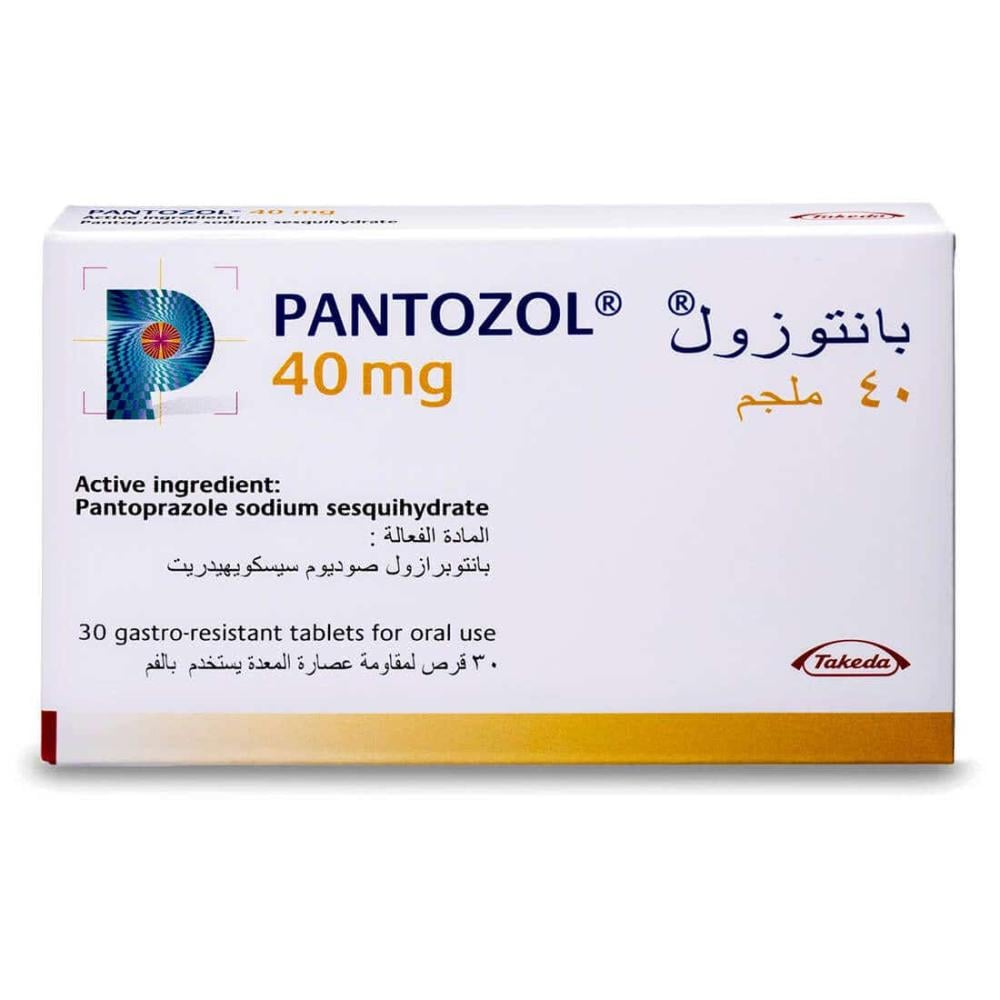

Pantoprazole 40 mg gastro-resistant tablets
What is pantoprazole and what is it used for?
Pantoprazole belongs to a class of medications known as proton pump inhibitors (PPIs). It is used for the short-term treatment of adults with signs and symptoms of gastroesophageal reflux disease (GERD), such as regurgitation and heartburn.
Do not take pantoprazole:
• If you are allergic to pantoprazole or any other ingredients in this medicine, tell your doctor about the symptoms you experience.
• If you are taking HIV protease inhibitors (medicines used to treat HIV), such as atazanavir and nelfinavir.
Warnings and precautions:
• Talk to your doctor or pharmacist if you experience an allergic reaction to this medicine or have previously experienced an allergic reaction to medicines similar to this medicine (proton pump inhibitors). Signs of an allergic reaction include shortness of breath, rash, swelling of the face or neck, low blood pressure, and dizziness.
• Be sure to tell your doctor if you have liver problems, jaundice (yellowing of the eyes and skin), anemia, bleeding in the stomach or intestines, unintentional weight loss, difficulty swallowing, persistent vomiting or vomiting blood, and any other medical problem.
• Be sure to tell your doctor if you have ever had a stomach ulcer or surgery on your stomach or intestines.
• Consult your doctor if you are undergoing continuous treatment for symptoms of heartburn or indigestion for 4 weeks or more.
• Be sure to tell your doctor if your symptoms are new or have recently changed and you are over 55 years old.
• Be sure to follow up with your doctor regularly if you are over 55 and take over-the-counter heartburn medications almost every day.
• Consult your doctor if you will have an endoscopy or urea breath test before starting the medication.
• This medication may not provide immediate relief after taking it. It is expected to start working after one day of treatment and may take up to 7 days to provide complete relief.
• Do not take this medicine as a preventative measure for gastric reflux.
• Do not take any other heartburn medicine with this medicine, unless your doctor tells you to.
• This medication may increase your risk of stomach or intestinal infections caused by bacteria. Be sure to tell your doctor if you experience gastrointestinal symptoms, such as severe or persistent diarrhea, nausea, and vomiting.
• This medication may increase your risk of developing subacute cutaneous lupus erythematosus (SCLE), a skin disorder that typically develops on sun-exposed areas of the body, such as the shoulders, upper back, neck, extensor arms, and upper trunk, and is characterized by a red, raised, scaly rash. Contact your doctor immediately if you experience any side effects, such as a rash or joint pain. Your doctor may discontinue the medication if this occurs.
• This medication may interfere with certain laboratory tests required during investigations for neuroendocrine tumors (tumors arising from hormones and the nervous system). Therefore, your doctor may recommend stopping this medication at least 5 days before the test if necessary. Be sure to tell your doctor if you are having a specific blood test (chromogranin A).
• This medicine is usually used for up to 4 weeks, unless your doctor recommends a longer duration of taking the medicine.
• This medicine may affect your ability to absorb vitamin B12 if used for a long time.
• This medication may increase the risk of bone fractures if taken in high doses and for long periods (more than one year). The risk is higher in elderly patients, those with osteoporosis (low bone density), and those taking corticosteroids. Your doctor may recommend calcium and vitamin D supplements depending on your condition.
• This medication may cause low magnesium levels if used for three months or more. Signs of low magnesium levels include uncontrolled involuntary muscle movements, fatigue, confusion, convulsions, irregular heartbeat, and dizziness. Be sure to contact your doctor if you experience any of these signs. Your doctor may recommend measuring your magnesium levels before starting this medication, especially if you are at higher risk of low magnesium levels (such as long-term treatment with the medication or taking other medications with this medication that may worsen low blood magnesium levels). Low magnesium levels may also lead to low blood calcium or potassium levels.
• Be sure to tell your doctor if you do not feel better after two weeks of starting this medicine.
• Be sure to tell your doctor if you take this medicine for more than 4 weeks.
• Be sure to talk to your doctor immediately if you experience signs, such as vomiting especially if it is bloody and frequent (appears like dark coffee grounds), pale skin, weakness, black or bloody stools, stomach pain, unintentional weight loss that is not related to exercise or dieting, difficulty or pain when swallowing and chest pain.
• Your doctor may recommend some blood tests. Be sure to tell your doctor if you are scheduled for any blood test and that you are currently taking this medication.
Possible side effects:
Potential serious side effects of pantoprazole include signs of an allergic reaction, such as a rash; signs of serious skin reactions, such as bleeding and skin loss around the genitals, nose, mouth, or eyes, or blistering or peeling of the skin; a rash with swelling and a rash on sun exposure; signs of liver damage, such as yellowing of the eyes and skin; and signs of kidney damage, such as lower back pain with a high fever and painful urination. Common side effects include polyps in the stomach. Other uncommon or rare side effects include headache, diarrhea, feeling sick, bloating, vomiting, dry mouth, dizziness, constipation, rash, feeling tired or weak, stomach discomfort and pain, itching, fractures of the spine, hip, or wrist, sleep problems, joint or muscle pain, increased liver enzymes in a blood test, changes or loss of sense of taste, blurred vision, joint pain, weight changes, enlarged breasts in males, fever, swelling of the extremities, depression, increased bilirubin and lipid levels, severe decrease in circulating granulocyte white blood cells, low platelet count (can cause easy bruising, delayed wound healing, and bleeding), loss of coordination and orientation, low white blood cells (may increase the risk of infection), decreased red blood cells, watery diarrhea, burning or numbness sensation, tingling, pins and needles, or prickling sensation, confusion, low blood magnesium and sodium levels, hallucinations, and rash with joint pain.
Other medicines and pantoprazole:
Tell your doctor or pharmacist if you are taking, have recently taken or might take any other medicines.
• If you are taking certain antifungal medications such as ketoconazole (used to treat fungal infections).
• If you are taking HIV protease inhibitors (medicines used to treat HIV), such as atazanavir and nelfinavir.
• If you are taking warfarin or phenprocoumon (blood thinners).
• If you are taking methotrexate (used to treat rheumatoid arthritis, psoriasis, and cancer).
• If you are taking other medications to reduce acid, such as another proton pump inhibitor (e.g., lansoprazole, omeprazole, rabeprazole) or an H2 antagonist (e.g., famotidine, ranitidine). Antacids (e.g., alginic acid, magglutinins, aluminum hydroxide, sodium bicarbonate, magnesium carbonate, or combinations) can be safely taken with this medication if needed.
How to take pantoprazole:
Adults:
The recommended dose is one tablet (20 mg) taken orally daily.
children:
The safety and effectiveness of this medicine have not yet been established in children.
• Take this medicine as directed in this leaflet or as advised by your doctor or pharmacist.
• Make sure to take this medicine for at least 2 to 3 consecutive days.
• Stop taking this medicine when you feel completely relieved from your symptoms.
• Do not take the medicine for more than 4 weeks unless your doctor recommends it.
• Take the tablet before a meal.
• Take the medicine at the same time every day.
• Swallow the tablet whole with a glass of water. Do not break or chew the tablet.
How to store pantoprazole:
• Do not store the medicine at extreme temperatures.
• Keep this medicine out of reach of children and pets.
• Do not use the medicine after the expiry date shown on the carton.
• Keep the medicine in its original package to protect it from moisture and light.
• Do not use damaged grains.
• Do not dispose of medicines in wastewater or household waste.
